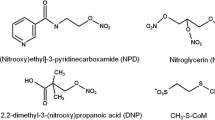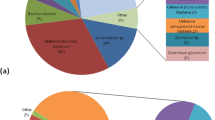Abstract
The ability of ruminal microbes to degrade the explosive compound hexahydro-1,3,5-trinitro-1,3,5-triazine (RDX) in ovine whole rumen fluid (WRF) and as 24 bacterial isolates was examined under anaerobic conditions. Compound degradation was monitored by high-performance liquid chromatography analysis, followed by liquid chromatography–tandem mass spectrometry identification of metabolites. Organisms in WRF microcosms degraded 180 μM RDX within 4 h. Nitroso-intermediates hexahydro-1-nitroso-3,5-dinitro-1,3,5-triazine (MNX), hexahydro-1,3-dinitroso-5-nitro-1,3,5-triazine (DNX), and hexahydro-1,3,5-trinitroso-1,3,5-triazine (TNX) were present as early as 0.25 h and were detected throughout the 24-h incubation period, representing one reductive pathway of ring cleavage. Following reduction to MNX, peaks consistent with m/z 193 and 174 were also produced, which were unstable and resulted in rapid ring cleavage to a common metabolite consistent with an m/z of 149. These represent two additional reductive pathways for RDX degradation in ovine WRF, which have not been previously reported. The 24 ruminal isolates degraded RDX with varying efficiencies (0–96 %) over 120 h. Of the most efficient degraders identified, Clostridium polysaccharolyticum and Desulfovibrio desulfuricans subsp. desulfuricans degraded RDX when medium was supplemented with both nitrogen and carbon, while Anaerovibrio lipolyticus, Prevotella ruminicola, and Streptococcus bovis IFO utilized RDX as a sole source of nitrogen. This study showed that organisms in whole rumen fluid, as well as several ruminal isolates, have the ability to degrade RDX in vitro and, for the first time, delineated the metabolic pathway for its biodegradation.





Similar content being viewed by others
References
Adrian NR, Arnett CM, Hickey RF (2003) Stimulating the anaerobic biodegradation of explosives by the addition of hydrogen or electron donors that produce hydrogen. Water Res 37:3499–3507
Agency for Toxic Substances and Disease Registry (1995) Toxicological profile for RDX. US Department of Health and Human Services, Public Health Service, Atlanta
Arnett CM, Adrian NR (2009) Cosubstrate independent mineralization of hexahydro-1,3,5-trinitro-1,3,5-triazine (RDX) by a Desulfovibrio species under anaerobic conditions. Biodegradation 20:15–26
Axtell C, Johnston CG, Bumpus JA (2000) Bioremediation of soil contaminated with explosives at the Naval Weapons Station Yorktown. Soil Sediment Contam 9:537–548
Banerjee HM, Verma M, Hou L-H, Ashraf M, Dutta SK (1999) Cytotoxicity of TNT and its metabolites. Yale J Biol Med 72:1–4
Bayman P, Ritchey SD, Bennett JW (1995) Fungal interactions with the explosive RDX (hexahydro-1,3,5-trinitro-1,3,5-triazine). J Ind Microbiol 15:418–423
Best EPH, Sprecher SL, Larson SL, Fredrickson HL, Bader DF (1999) Environmental behavior of explosives in groundwater from the Milan army ammunition plant in aquatic and wetland plant treatments. Removal, mass balances and fate in groundwater of TNT and RDX. Chemosphere 38:3383–3396
Boopathy R, Manning J, Kulpa CF (1998) Biotransformation of explosives by anaerobic consortia in liquid culture and in soil slurry. Int Biodeterior Biodegrad 41:67–74
Borton C, Olson L (2006) Trace level analysis of explosives in ground water and soil. Application note: explosive analysis. Forster City, CA, Applied Biosystems, pp 1–6
Brooks LR, Jacobson RW, Warren SH, Kohan MJ, Donnelly KC, George SE (1997) Mutagenicity of HPLC-fractionated urinary metabolites from 2,4,6-trinitrotoluene-treated Fischer 344 rats. Environ Mol Mutag 30:298–302
Clausen J, Robb J, Curry D, Korte N (2004) A case study of contaminants on military ranges: Camp Edwards, Massachusetts, USA. Environ Pollut 129:13–21
Coleman NV, Nelson DR, Duxbury T (1998) Aerobic biodegradation of hexahydro-1,3,5-trinitro-1,3,5-triazine (RDX) as a nitrogen source by a Rhodococcus sp., strain DN22. Soil Biol Biochem 30:1159–1167
Crocker FH, Thompson KT, Szecsody JE, Fredrickson HL (2005) Biotic and abiotic degradation of CL-20 and RDX in soils. J Environ Qual 34:2208–2216
Crocker FH, Indest KJ, Fredrickson HL (2006) Biodegradation of the cyclic nitramine explosives RDX, HMX, and CL-20. Appl Microbiol Biotechnol 73:274–290
Daniels J.I. and Knezovich J.P. (1994) Human health risks from TNT, RDX, and HMX in environmental media and consideration of the U.S. Regulatory Environment. In International Symposium on the Rehabilitation of Former Military Sites and Demilitarization of Explosive Ordnance. Kirchberg, Luxembourg: Proceedings Demil '94
De Lorme M. and Craig A.M. (2009) Biotransformation of 2,4,6-trinitrotoluene by pure culture ruminal bacteria. Curr Microbiol 58: 81–86
Duringer JM, Craig AM, Smith DJ, Chaney RL (2010) Uptake and transformation of soil [14-C]-trinitrotoluene by cool-season grasses. Environ Sci Technol 44:6325–6330
Eaton H.L., De Lorme M., Chaney R. and Craig A.M. (2011) Ovine ruminal microbes are capable of biotransforming hexahydro-1,3,5-trinitro-1,3,5-triazine (RDX). Microb Ecol 62:274–286
Environmental Protection Agency US (1993) Risk estimate for carcinogenicity and reference dose for oral exposure for 2, 4, 6-trinitrotoluene. Office of Health and Environmental Assessment, US EPA, Washington, DC
Fleischmann TJ, Walker KC, Spain JC, Hughes JB, Morrie Craig A (2004) Anaerobic transformation of 2,4,6-TNT by bovine ruminal microbes. Biochem Biophys Res Commun 314:957–963
Fournier D, Trott S, Hawari J, Spain J (2005) Metabolism of the aliphatic nitramine 4-nitro-2,4-diazabutanal by Methylobacterium sp. strain JS178. Appl Environ Microbiol 71:4199–4202
Fuller ME, Lowey JM, Schaefer CE, Steffan RJ (2005) A peat moss-based technology for mitigating residues of the explosives TNT, RDX, and HMX in soil. Soil Sediment Contam 14:373–385
Fuller ME, McClay K, Hawari J, Paquet L, Malone TE, Fox BG, Steffan RJ (2009) Transformation of RDX and other energetic compounds by xenobiotic reductases XenA and XenB. Appl Microbiol Biotechnol 84:535–544
Gust KA, Pirooznia M, Quinn MJ Jr, Johnson MS, Escalon L, Indest KJ, Guan X, Clarke J, Deng Y, Gong P, Perkins EJ (2009) Neurotoxicogenomic investigations to assess mechanisms of action of the munitions constituents RDX and 2,6-DNT in Northern Bobwhite (Colinus virginianus). Toxicol Sci 110:168–180
Hawari J, Beaudet S, Halasz A, Thiboutot S, Ampleman G (2000a) Microbial degradation of explosives: biotransformation versus mineralization. Appl Microbiol Biotechnol 54:605–618
Hawari J, Halasz A, Sheremata T, Beaudet S, Groom C, Paquet L, Rhofir C, Ampleman G, Thiboutot S (2000b) Characterization of metabolites during biodegradation of hexahydro-1,3,5-trinitro-1,3,5-triazine (RDX) with municipal anaerobic sludge. Appl Environ Microbiol 66:2652–2657
Hesselmann RMX, Stenstrom MK (1994) Treatment concept for RDX-containing wastewaters using activated carbon with offline solvent biological regeneration. CA University of California, Los Angeles, Los Angeles
Hobson PN, Stewart CS (1997) The rumen microbial ecosystem. Blackie Academic and Professional, New York
Krishnan IS, Singhal RK, Dua RD (1986) Purification and characterization of glutamine synthetase from Clostridium pasteurianum. Biochemistry (Mosc) 25:1589–1599
Kumada Y, Benson DR, Hillemann D, Hosted TJ, Rochefort DA, Thompson CJ, Wohlleben W, Tateno Y (1993) Evolution of the glutamine synthetase gene, one of the oldest existing and functioning genes. Proc Natl Acad Sci 90:3009–3013
Kwon MJ, Finneran KT (2006) Microbially mediated biodegradation of hexahydro-1,3,5-trinitro-1,3,5-triazine by extracellular electron shuttling compounds. Appl Environ Microbiol 72:5933–5941
McCormick NG, Feeherry FE, Levinson HS (1976) Microbial transformation of 2,4,6-trinitrotoluene and other nitroaromatic compounds. Appl Environ Microbiol 31:949–958
Prescott LM, Harley JP, Klein DA (2005) Microbiology. McGraw-Hill, New York
Qasim MM, Moore B, Taylor L, Honea P, Gorb L, Leszczynski J (2007) Structural characteristics and reactivity relationships of nitroaromatic and nitramine explosives—a review of our computational chemistry and spectroscopic research. Int J Mol Sci 8:1234–1264
Sejrsen K, Hvelplund T, Nielsen MO (2006) Ruminant physiology: digestion, metabolism and impact of nutrition on gene expression, immunology and stress. Wageningen Academic, Wageningen
Smith DJ, Craig AM, Duringer JM, Chaney RL (2008) Absorption, tissue distribution, and elimination of residues after 2,4,6-trinitro[14 C]toluene administration to sheep. Environ Sci Technol 42:2563–2569
Stenuit BA, Agathos SN (2010) Microbial 2,4,6-trinitrotoluene degradation: could we learn from (bio)chemistry for bioremediation and vice versa? Appl Microbiol Biotechnol 88:1043–1064
Sunahara GI, Guilherme L, Kuperman RG, Hawari J (2009) Ecotoxicology of explosives. CRC, Boca Raton
Talley JW, Sleeper PM (1997) Roadblocks to the implementation of biotreatment strategies. Ann New York Acad Sci 829:16–29
Turley SD, Burton DT (1995) Reduction of hexahydro-l,3,5-trinitro-l,3,5-triazine (RDX) toxicity to the Cladoceran Ceriodaphniadubia following photolysis in sunlight. Bull Environ Contam Toxicol 55:89–95
U. S. Environmental Protection Agency (2007) Method 8330A (SW-846): Nitroaromatics and nitramines by high performance liquid chromatography (HPLC). EPA, Washington, DC
U.S. Environmental Protection Agency (2009) Hexahydro-1,3,5-trinitro-1,3,5-triazine (RDX). Environmental Protection Agency, Washington, DC
Williams RT, Ziegenfuss PS, Sisk WE (1992) Composting of explosives and propellant contaminated soils under thermophilic and mesophilic conditions. J Ind Microbiol 9:137–144
Zhang C, Hughes JB (2003) Biodegradation pathways of hexahydro-1,3,5-trinitro- 1,3,5-triazine (RDX) by Clostridium acetobutylicum cell-free extract. Chemosphere 50:665–671
Zhao JS, Paquet L, Halasz A, Hawari J (2003) Metabolism of hexahydro-1,3,5-trinitro-1,3,5-triazine through initial reduction to hexahydro-1-nitroso-3,5-dinitro-1,3,5-triazine followed by denitration in Clostridium bifermentans HAW-1. Appl Microbiol Biotechnol 63:187–193
Acknowledgments
The authors would like to thank Michael Wiens for his technical assistance. This research was supported in part by a gift from Ruminant Solutions, LLC (New Mexico), the Oregon Agricultural Experiment Station project no. ORE00871, and the US Department of Agriculture, Agriculture Research Service project no. 50-1265-6-076. Any opinions, findings, conclusions, or recommendations expressed in this publication are those of the author(s) and do not necessarily reflect the view of the US Department of Agriculture.
Author information
Authors and Affiliations
Corresponding author
Rights and permissions
About this article
Cite this article
Eaton, H.L., Duringer, J.M., Murty, L.D. et al. Anaerobic bioremediation of RDX by ovine whole rumen fluid and pure culture isolates. Appl Microbiol Biotechnol 97, 3699–3710 (2013). https://doi.org/10.1007/s00253-012-4172-3
Received:
Revised:
Accepted:
Published:
Issue Date:
DOI: https://doi.org/10.1007/s00253-012-4172-3




